|

|
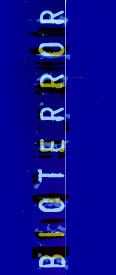
|
|
History of Biowarfare
Medieval Siege |
American Revolution |
WW I | WW II |
Cold War |
Soviet "Superbugs" |
Iraq's Secret Weapons |
The Cults |
Anthrax Attacks
|
 When loaded with diseased bodies, wood-frame
catapults were biological weapons.
When loaded with diseased bodies, wood-frame
catapults were biological weapons.
|
Medieval Siege
In the 14th and 15th centuries, little
was known about how germs cause disease. But according to
medieval medical lore, the stench of rotting bodies was
known to transmit infections. So when corpses were used as
ammunition, they were no doubt intended as biological
weapons.
Three cases are well-documented:
1340
Attackers hurled dead horses and other animals by catapult
at the castle of Thun L'Eveque in Hainault, in what is now
northern France. The defenders reported that "the stink and
the air were so abominable...they could not long endure" and
negotiated a truce.
1346
As Tartars launched a siege of Caffa, a port on the Crimean
peninsula in the Black Sea, they suffered an outbreak of
plague. Before abandoning their attack, they sent the
infected bodies of their comrades over the walls of the
city. Fleeing residents carried the disease to Italy,
furthering the second major epidemic of "Black Death" in
Europe.
1422
At Karlstein in Bohemia, attacking forces launched the
decaying cadavers of men killed in battle over the castle
walls. They also stockpiled animal manure in the hope of
spreading illness. Yet the defense held fast, and the siege
was abandoned after five months.

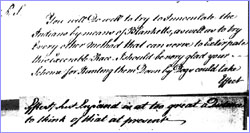 Gen. Jeffrey Amherst, in a letter dated 16 July
1763, approved the plan to spread smallpox to
Delaware Indians.
Gen. Jeffrey Amherst, in a letter dated 16 July
1763, approved the plan to spread smallpox to
Delaware Indians.
|
|
American Revolution
While the first true vaccine for smallpox was not invented
until 1796, the practice of deliberately inoculating people
with a mild form of the disease was established decades
earlier. The British military likely employed such
deliberate infection to spread smallpox among forces of the
Continental Army.
The British routinely inoculated their own troops, exposing
soldiers to the material from smallpox pustules to induce a
mild case of disease and, once they recovered, life-long
immunity. But in Boston, and perhaps also Quebec, the
British may have forced smallpox on civilians. As they fled
the besieged cities these civilians, the British hoped,
would carry smallpox to rebel troops.
In Boston the mission seems to have failed; the infected
civilians were quarantined and thus kept from Continental
soldiers. But in Quebec, smallpox swept through the
Continental Army, helping to prompt a retreat.
Using smallpox as a weapon was not unprecedented for the
British military; Native Americans were the targets of
attack earlier in the century. One infamous and
well-documented case occurred in 1763 at Fort Pitt on the
Pennsylvania frontier. British Gen. Jeffery Amherst ordered
that blankets and handkerchiefs be taken from smallpox
patients in the fort's infirmary and given to Delaware
Indians at a peace-making parley.
|
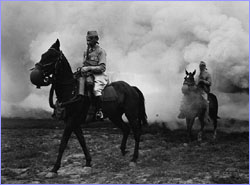 After the war, cavalries were trained to expect
attacks with chemical and biological weapons.
After the war, cavalries were trained to expect
attacks with chemical and biological weapons.
|
World War I
By the time of The Great War, the germ theory of disease was
well established; scientists grasped how microbes such as
bacteria and viruses transmit illness. During the war,
German scientists and military officials applied this
knowledge in a widespread campaign of biological
sabotage.
Their target was livestock—the horses, mules, sheep,
and cattle being shipped from neutral countries to the
Allies. The diseases they cultivated as weapons were
glanders and anthrax, both known to ravage populations of
grazing animals in natural epidemics. By infecting just a
few animals, through needle injection and pouring bacteria
cultures on animal feed, German operatives hoped to spark
devastating epidemics.
Secret agents waged this campaign in Romania and the U.S.
from 1915-1916, in Argentina from roughly 1916-1918, and in
Spain and Norway (dates and details are obscure). Despite
the claims of some agents, their overall impact on the war
was negligible.
The much more apparent horrors of chemical warfare led, in
1925, to the Geneva Protocol. It prohibits the use of
chemical and biological agents, but not research and
development of these agents.
The United States signed the Protocol, yet 50 years passed
before the U.S. Senate voted to ratify it. Japan also
refused to ratify the agreement in 1925.
 The Japanese army used Chinese prisoners to test
bioweapons. (These particular men may not have been
subjects.)
The Japanese army used Chinese prisoners to test
bioweapons. (These particular men may not have been
subjects.)
|
|
World War II
While Germany dabbled with biological weapons in World War
I, the Japanese military practiced biowarfare on a mass
scale in the years leading up to and throughout World War
II. Directed against China, the onslaught was spearheaded by
a notorious division of the Imperial Army called Unit
731.
In occupied Manchuria, starting around 1936, Japanese
scientists used scores of human subjects to test the
lethality of various disease agents, including anthrax,
cholera, typhoid, and plague. As many as 10,000 people were
killed.
In active military campaigns, several hundred thousand
people—mostly Chinese civilians—fell victim. In
October 1940, the Japanese dropped paper bags filled with
plague-infested fleas over the cities of Ningbo and Quzhou
in Zhejiang province. Other attacks involved contaminating
wells and distributing poisoned foods. The Japanese army
never succeeded, though, in producing advanced biological
munitions, such as pathogen-laced bombs.
As the leaders of Unit 731 saw Japan's defeat on the
horizon, they burned their records, destroyed their
facilities, and fled to Tokyo. Later, in the hands of U.S.
forces, they brokered a deal, offering details of their work
in exchange for immunity to war crimes prosecution.
By the end of WWII, the Americans and Soviets were far along
on their own paths in developing biological weapons.
|
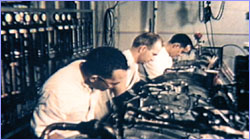 Weapons production at Fort Detrick, Maryland, the
U.S. Army's base for biowarfare research.
Weapons production at Fort Detrick, Maryland, the
U.S. Army's base for biowarfare research.
|
Cold War
While ignited by World War II, bioweapons programs in the
Soviet Union and the U.S. reached new heights in the anxious
climate of the Cold War. Both nations explored the use of
hundreds of different bacteria, viruses, and biological
toxins. And each program devised sophisticated ways to
disperse these agents in fine-mist aerosols, to package them
in bombs, and to launch them on missiles.
In 1969, the U.S. military celebrated the success of a
massive field test in the Pacific. The
wargame—involving a fleet of ships, caged animals, and
the release of lethal agents—provided proof of the
impact of bioweapons. Little did the U.S. team know,
however, that Soviet spies were in nearby waters, collecting
samples of the agents tested.
At the end of 1969, likely prompted by Vietnam War protests,
President Richard Nixon terminated the offensive biological
warfare program and ordered all stockpiled weapons
destroyed. From this point on, U.S. researchers switched
their focus to defensive measures such as developing
"air-sniffing" detectors.
In 1972, the U.S. and more than 100 nations sign the
Biological and Toxin Weapons Convention, the world's first
treaty banning an entire class of weapons. The treaty bars
possession of deadly biological agents except for defensive
research. Yet no clear mechanisms to enforce the treaty
existed. And just as it signed the treaty, the Soviet Union
fired up its offensive program.
Soviet "Superbugs"
In 1979, a rare outbreak of anthrax disease in the city of
Sverdlovsk killed nearly 70 people. The Soviet government
publicly blamed contaminated meat, but U.S. intelligence
sources suspected the outbreak was linked to secret weapons
work at a nearby army lab.
In 1992, Russia allowed a U.S. team to visit Sverdlovsk. The
team's investigation turned up telltale evidence in the
lungs of victims that many died from inhalation anthrax,
likely caused by the accidental release of aerosolized
anthrax spores from the military base. Given the hundreds of
tons of anthrax the Sverdlovsk facility could produce, the
release of just a small amount of spores was fortunate.
News of the immensity of the Soviets' biological weapons
program began to reach the West in 1989, when biologist
Vladimir Pasechnik defected to Britain. The stories he
told—of genetically altered "superplague,"
antibiotic-resistant anthrax, and long-range missiles
designed to spread disease—were confirmed by later
defectors like Ken Alibek and Sergei Popov.
The Soviet program was spread over dozens of facilities and
involved tens of thousands of specialists. In the late 1980s
and 1990s, many of these scientists became free
agents—with dangerous knowledge for sale.
|
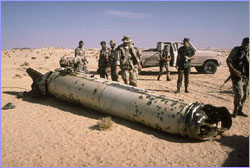 During Operation Desert Storm, the U.S. military
feared that Scud missiles might contain biological
agents.
During Operation Desert Storm, the U.S. military
feared that Scud missiles might contain biological
agents.
|
Iraq's Secret Weapons
As the Soviet Union's program began to crumble in the 1990s,
and scientists' salaries dwindled, some bioweapons experts
may have been lured to Iraq. Iraq launched its own
bioweapons program around 1985 but initially lacked the
expertise to develop sophisticated arms.
By the time of the Gulf War cease-fire in 1991, however,
Iraq had weaponized anthrax, botulinum toxin, and aflatoxin
and had several other lethal agents in development.
Inspectors from the U.N. Special Commission (UNSCOM) spent
frustrating years chasing down evidence of the program,
which Iraq repeatedly denied existed. The UNSCOM team found
that Iraq's stockpile included Scud missiles loaded to
deliver disease.
Iraq is known to have unleashed chemical weapons in the
1980s, both during the Iran-Iraq war and against rebellious
Kurds in northern Iraq. But there is no evidence that the
Iraqi state has ever used its biological arsenal.
What is almost certain, though, is that this arsenal still
exists in 2001. In fact, with the aid of former Soviet
experts and UNSCOM inspectors kept at bay, the Iraqi arsenal
is likely growing in power.
 The Aum Shinrikyo cult claimed tens of thousands of
members.
The Aum Shinrikyo cult claimed tens of thousands of
members.
|
|
The Cults
In 1984, followers of the Indian guru Bagwan Shree Rajneesh,
living on a compound in rural Oregon, sprinkled
Salmonella on salad bars throughout their county. It
was a trial run for a proposed later attack. The
Rajneeshees' scheme was to sicken local citizens and thus
prevent them from voting in an upcoming election.
The trial attack was successful; it triggered more than 750
cases of food poisoning, 45 of which required
hospitalization. The Centers for Disease Control and
Prevention launched an investigation but concluded that the
outbreak was natural. It took a year, and an independent
police investigation, to discover the true source of the
attack.
While this first bioterrorist act on American soil went
almost unnoticed, a decade later the work of another cult
sparked a flurry of media coverage and government
response.
In 1995, the apocalyptic religious sect Aum Shinrikyo
released sarin gas in a Tokyo subway, killing 12 commuters
and injuring thousands. The cult also had enlisted Ph.D.
scientists to launch biological attacks. Between 1993 and
1995, Aum Shinrikyo tried as many as 10 times to spray
botulinum toxin and anthrax in downtown Tokyo.
Just why the attacks failed is not known, but some experts
suspect the cult did not sufficiently refine the particle
size of its agents and that it was working with an avirulent
strain of anthrax.
|
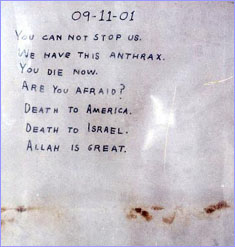 When these letters were opened, the fine-grained
anthrax within them misted into the air.
When these letters were opened, the fine-grained
anthrax within them misted into the air.
|
Anthrax Attacks
For more than two decades, bioterrorism experts warned that
America may be vulnerable to attack with biological weapons.
In the fall of 2001, these warnings took on a new urgency.
A week after the terrorist attacks of September
11th, a letter containing anthrax spores was
mailed to Tom Brokaw at NBC News in New York. Two other
letters with nearly identical handwriting, venomous
messages, and lethal spores arrived at the offices of the
New York Post and Senator Tom Daschle in Washington,
D.C.
By the end of the year, 18 people had been infected with
anthrax, five people had died of the inhaled form of the
disease, and hundreds of millions more were struck by
anxiety of the unknown.
As New York Times reporter Judith Miller notes in
NOVA's "Bioterror," the anthrax-laced letters sparked "mass
disruption" rather than "mass destruction."
But the story is continuing to unfold.
Photos: (1) WGBH/NOVA; (2,5) National Archives and Records
Administration; (3) Native Web, www.nativeweb.org; (4,
6-10) Corbis Images.
History of Biowarfare
|
Future Germ Defenses
Interviews with Biowarriors
|
Global Guide to Bioweapons
|
Making Vaccines
Resources
|
Teacher's Guide
|
Transcript
|
Site Map
|
Bioterror Home
Search |
Site Map
|
Previously Featured
|
Schedule
|
Feedback |
Teachers |
Shop
Join Us/E-Mail
| About NOVA |
Editor's Picks
|
Watch NOVAs Online
|
To Print
PBS Online |
NOVA Online |
WGBH
©
| Updated February 2002
|
|
|
|